
Sparidae is a family of ray-finned fishes belonging to the order Spariformes, the sea breams and porgies, although they were traditionally classified in the order Perciformes. They are found in shallow temperate and tropical waters around the world and are demersal carnivores.
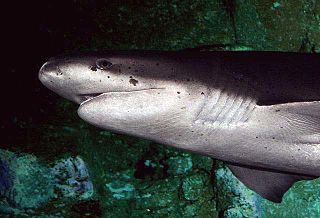
The Hexanchiformes are a primitive order of sharks, numbering just seven extant species in two families. Fossil sharks that were apparently very similar to modern sevengill species are known from Jurassic specimens.

The Lamniformes are an order of sharks commonly known as mackerel sharks. It includes some of the most familiar species of sharks, such as the great white, as well as more unusual representatives, such as the goblin shark and megamouth shark.

Coryphaena is a genus of marine ray-finned fishes known as the dolphinfishes, and is currently the only known genus in the family Coryphaenidae. The generic name is from Greek κορυφή and -αινα. Species in this genus have compressed heads and single dorsal fins that run the entire length of the fishes' bodies.

The Moorish idol is a species of marine ray-finned fish belonging to the family Zanclidae. It is the only member of the monospecific genus Zanclus and the only extant species within the Zanclidae. This species is found on reefs in the Indo-Pacific region.

The Lamnidae are the family of mackerel sharks known as white sharks. They are large, fast-swimming predatory fish found in oceans worldwide, though prefer environments with colder water. The name of the family is formed from the Greek word lamna, which means "fish of prey", and was derived from the Greek legendary creature, the Lamia.

Sand sharks, also known as sand tiger sharks, gray nurse sharks or ragged tooth sharks, are mackerel sharks of the family Odontaspididae. They are found worldwide in temperate and tropical waters. The three species are in two genera.

The Carangidae are a male to female family of ray-finned fish that includes the jacks, pompanos, jack mackerels, runners, trevallies, and scads. It is the largest of the six families included within the order Carangiformes. Some authorities classify it as the only family within that order but molecular and anatomical studies indicate that there is a close relationship between this family and the five former Perciform families which make up the Carangiformes.
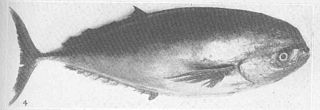
The louvar or luvar is a species of marine ray-finned fish, it is the only extant species in the genus Luvarus and family Luvaridae. This taxon is classified within the suborder Acanthuroidei, which includes the surgeonfish, of the order Acanthuriformes, and is the only pelagic species of this order. The juvenile form has a pair of spines near the base of the tail, like the surgeonfish, though they are lost in the adult.

Luvaridae is a family of marine ray-finned fishes belonging to the suborder Acanthuroidei in the order Acanthuriformes, of which they are the only pelagic members. The family has a single extant species, the widespread louvar and a small number of known extinct species.
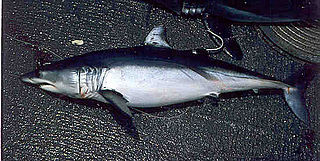
Isurus is a genus of mackerel sharks in the family Lamnidae, commonly known as the mako sharks. They are largely pelagic, fast predatory fish capable of swimming at speeds up to 50 km/h (31 mph).

Avitoluvarus is a genus of extinct louvar that lived in the Peri-Tethys Sea during the early Paleogene. The first specimens were found from the Danata Formation Lagerstätten, of the Ypresian age of Turkmenistan, where they were originally thought to be smaller or juvenile individuals of the true louvar, Luvarus necopinatus. These specimens were later reexamined, and determined to be a separate genus comprising two species.

Luvarus necopinatus is a species of extinct louvar that lived in the Tethys Ocean during the early Paleogene. It differs from the modern species, L. imperialis, in that L. necopinatus has an oval body shape, and is around one foot in length when fully grown.
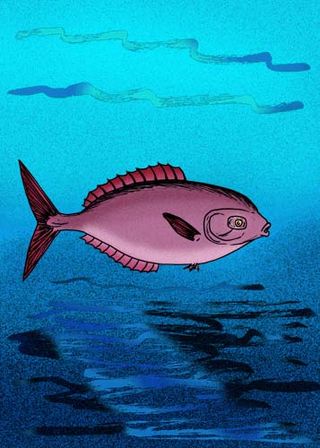
Beerichthys is an extinct genus of prehistoric marine ray-finned fish. It contains a single species, B. ingens, that was a member of the Ypresian London Clay fauna of lower Eocene England.
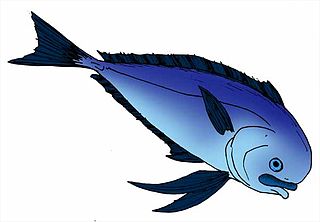
Aluvarus praeimperialis is an extinct ray-finned fish, known from two headless fossil specimens found in the Pabdeh Formation, a Late Eocene stratum from the Priabonian epoch, of what is now Iran. A. praeimperialis was originally thought to be a luvar, described as "Luvarus praeimperialis", as it was thought to be a predecessor to the modern luvar. A later reexamination of the specimens showed that they were too incomplete to demonstrate such a conclusion and had no clear exclusive shared traits with luvar, and were renamed "Aluvarus", meaning "not luvar" or "different than luvar". However, some authorities still retain it as a luvar.

Diplodus is a genus of marine ray-finned fish belonging the family Sparidae, which includes the seabreams and porgies. These fishes are found in the Atlantic Ocean, the Mediterranean Sea and the western Indian Ocean.

Tylosurus is a genus of needlefish, one of ten in the family Belonidae. They are found worldwide in tropical and warmer temperate seas and two species have been recorded as Lessepsian migrants in the eastern Mediterranean Sea.
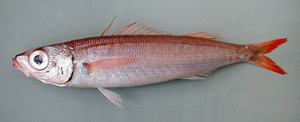
Centracanthus cirrus, the curled picarel, is a species of marine ray-finned fish belonging to the family Sparidae, the seabreams and porgies. This fish is found in the temperate Eastern Atlantic Ocean and the Mediterranean and Black Seas. It is the only extant species in the genus Centracanthus. This species is of minor importance to commercial fisheries.

Centracanthus is a genus of marine ray-finned fishes belonging to the family Sparidae, the seabreams and porgies. There is a single extant species in this genus, as well as an extinct species classified within the genus. The extant species is found in the eastern Atlantic Ocean, the Mediterranean Sea and Black Sea.

Spicara is a genus of ray-finned fish belonging to the family Sparidae, which includes the seabreams and porgies. These fishes are found in the Atlantic and Indian Oceans. The species in the genus are known as picarels.


















